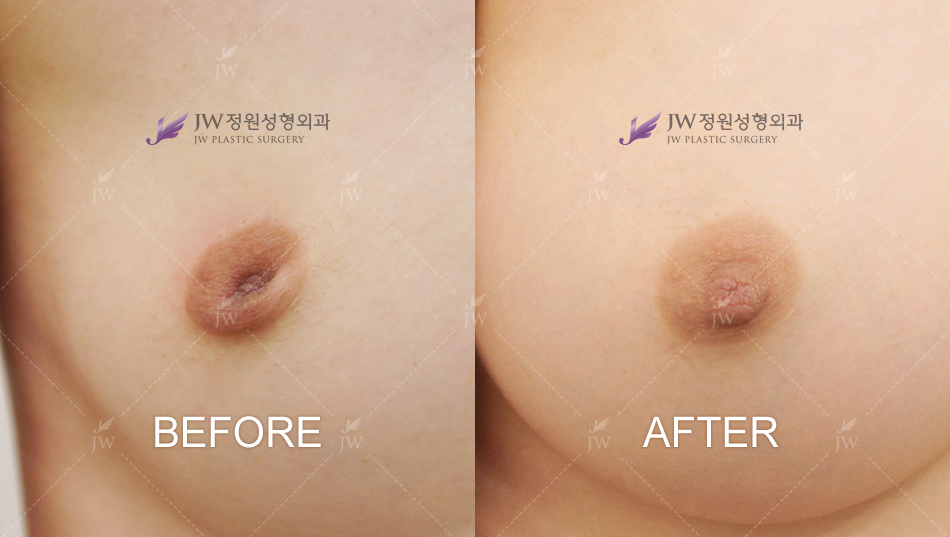
Natural harmony between breast, nipple, & areola
Nipples and areola are definitive for beautiful breasts. The harmony between the breasts, nipples, and areolae is what makes the breasts truly beautiful.
Therefore, patients seek to correct inverted or large and sagging nipples. We can improve these conditions through inverted nipple correction and nipple reduction surgery. In the case of dark nipples and areola, a whitening procedure can help lighten the color. Excessively large areola can be corrected with the areola reduction surgery
An inverted nipple is a condition where the nipple, instead of pointing outward, is flat or retracted into the breast. 3% of Korean women experience this phenomenon due to hereditary factors.
A nipple can become inverted because of a lack of supporting tissues on the lower part of the nipple, short lactiferous ducts, and the fibrous tissues which pull the nipples and prevent them from protruding.
Inverted nipples are considered aesthetically displeasing, cause secretions, inflammation, disturb breastfeeding, and hinder the nipple’s function as an erogenous zone; correcting inverted nipples can be beneficial since frequent inflammations and difficulty in breastfeeding may increase breast cancer rates.

Small holes are drilled around the nipple which works in a similar fashion as the double eyelid non-incision method.
The inverted nipple is pulled out and tissues under the nipple are filled to correct the inversion.
It’s important to preserve the lactiferous ducts as maximally as possible during the surgery while making enough correction to ensure there will be no relapse.
Good results cannot be achieved by using only one specific surgical procedure. In order to obtain good results, it is necessary to accurately diagnose the degree of inversion and choose the appropriate surgical method.
Surgery is performed under local anesthesia or sedation, and the operation time varies depending on the operation method (generally between 20 – 40 minutes).
Generally, the diameter of a nipple is about 1cm, and the height is about 7mm. An excessively large or long nipple can damage the harmony of the breasts. This condition is called nipple hypertrophy. Although it does not affect the functions of a nipple, many patients seek to correct the condition for aesthetic purposes.
Nipple hypertrophy is commonly an acquired condition, for example the nipples enlarge after breastfeeding, but some patients may have large nipples congenitally. During the surgery, the incision and removal of the excessive nipple tissue are followed by a suture. There are almost no visible scarring or side effects and the patients can return to normal life right after the operation.

This method is generally performed on those who have elongated nipples. The skin and tissues next to the nipple are removed, and the lactiferous ducts are preserved for breastfeeding.
Patients experience different degrees of postoperative complications based on their conditions. It’s important that you pay extra attention to the instructions for postoperative management.
JW surgeon for the Breast has been performing surgery with know-how from various clinical experiences, as well as dedication to achieving the best result by medical research.
